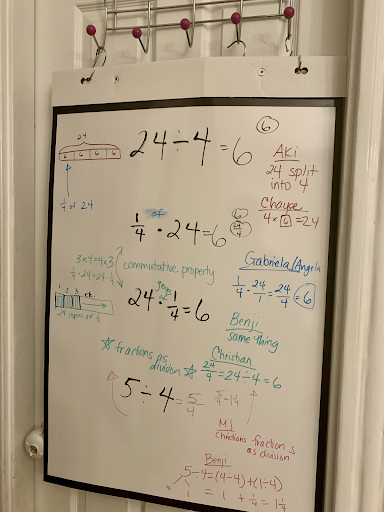Creating a Flexible, Adaptable Workspace
Jenna Laib, Grade 6 math, Driscoll School/Remote Learning Academy, Public Schools of Brookline.
For now, I am teaching sixth grade math via zoom. Multiple times per day, I meet with my classes synchronously from the comfort -- and chaos -- of my house. My children just turned 5 and 3 years old, and, while they attend preschool outside the home, cold symptoms have forced them to miss a few days. Sometimes, I let them boisterously co-teach with me. (My 5 year old daughter loves to help facilitate the ‘Which One Doesn’t Belong?’ routine!) Other times, I escape to rooms where I can zoom with more privacy. This means that having a single workspace setup won’t work for me.
 |
As I thought about setting up various work stations, it helped me to think about what is most important to me about my practice.
Making Thinking Visible
Both in the physical classroom and in my current zoom classroom, I write... a lot. During discourse-based routines, I annotate student thinking on the board. When students share their work, we mark it up using different colors as they speak. This all speaks to a central value of my practice: students have important ideas, and these ideas should be centered in math class. Making these ideas visible makes them more accessible for others in the classroom.
The zoom annotation tools have been great for much of that. I pull up student work samples, and we annotate to our heart’s content.
However, there are times when I long for the feeling of a dry erase marker in hand. The ink flows naturally. I can focus on the students and the mathematical ideas. Here’s an example of a ratio diagram that I drew the other day using zoom annotation tools. It is distractingly sloppy, but making it neater would have consumed too much class time, and lost student engagement.
 |
The Advantage of Whiteboards
Tracy Zager wrote about an informal experiment she conducted last August on twitter. Tracy, a math coach, tried facilitating the Number Talk routine both with markers on print outs, and computer-based annotation tools on google slides.
 |
 |
Creating Flexible, Adaptable Workspace...s (Plural)
So I knew I wanted to set up a whiteboard, but I wasn’t going to commit to a permanent white board in our dining room, no matter how much my kids might have enjoyed it. I tried to write on my kids’ plastic easel for one lesson, but it was a laughable flop.
Enter: The Wipebook Flipchart.
Because the wipebook flipchart comes with 10 sheets, I am able to set them up in different spaces around the house, and adjust them easily. There’s one that currently lives on a closet door. There is another that I put up in the dining room for instruction, and then remove for dinner so that we feel like we live in a house and not a school. I hung one on the fridge, too, for a lesson in the kitchen.
 |
Ratios in the Kitchen
To introduce equivalent ratios, we examine recipes. Equivalent fractions have different numbers that represent the same value. Equivalent ratios represent the same relationship, even if there are different amounts or values. In the case of a recipe, this means that scaling up or down shouldn’t change the taste.
To demonstrate, I mixed hot chocolate using two different recipes: A and B. I was able to draw diagrams to represent these recipes quickly and accurately on the Wipebook. I moved my laptop closer, so that students could see it more clearly.
 |
When I have taught this lesson in the classroom, pre-COVID, I allowed students to sample the drinks. That is not possible via zoom. A few students brought along ingredients to play along at home, but others seemed fully engaged without a hot chocolate in hand. I think it helped to have some movement on screen -- going towards the fridge to use the Wipebook, and then back to my kitchen island -- without any technological snags.
I left the chart up behind me for the duration of the lesson. Whenever a student wanted to reference it, I simply moved to the side, sparing everyone the 30 second pause in momentum. There didn’t have to be a “let me share my screen… oh… wait… let me find the image… yes… okay…. Here we go!” The flow felt more natural.
Wipebook Flipcharts around the House
Many times, screen-based annotation will be preferred and better for a given task or activity. I am so grateful to have it as a possibility. However, I think the WipeBook will continue to be critical for when I need to draw or write more freely. Students have expressed that it also feels more like “the classroom” -- the in person one that they miss.
 |
You may also like:
- Wipebook demonstrating resilience in the learning procsss
- Wipebook Workbooks transforming the classroom during Covid-19
- Wipebook Flipcharts; Our go to learning surface
